Lea en español
Outdoor tents erected by the University throughout Grounds have become a popular option for students seeking a change of scenery to get their work done or enjoy a meal.
Announced by the University at the beginning of the semester, the tents were designed as a place for students to study and meet in small groups in order to compensate for the reduced capacity of indoor locations due to COVID-19. The outdoor nature of the tents also limits the possibility of students spreading the virus to one another.
The University has constructed nine tents throughout Grounds at various locations, including across from the corner, the O-Hill Dining lawn, the McCormick Road Residence Hall’s central quad and the lawn in front of Peabody Hall. In total, the construction of these tents and the seating inside them cost approximately $650,000, according to University spokesperson Wes Hester.
Many students have been taking advantage of these new spaces on Grounds, especially in recent weeks as the outdoor temperature has continued to be warm. Among these students is second-year College student Molly Hayes, who is a frequent visitor. Hayes uses the tents multiple times a week as a place to study when she comes on Grounds for her in-person class, and often stays throughout the day. While the tents are popular places for many doing the same, Hayes says that the large capacities mean that there is usually a table available.
With multiple tents located close to the dining halls and the Corner, they also provide students with a place to enjoy a meal as they do their work.
Other students use the tents as a means of getting both the outdoor time and social interaction that they have been missing due to the pandemic, with some saying they hope the University keeps the tents up even after COVID-19 ceases to be a concern.
“I got a lot of my outside nature activity, honestly just each day by walking to class,” third-year College student Jay Ralyea said. “Now that that's missing given that the virus is going around and all that, this provides, while not as good of an opportunity, as close as I can get to going out and happening to run into people.”
While the University has encouraged students to use the spaces to socialize in small numbers, students are still expected to adhere to social distancing guidelines. Within the tents, tables are spaced over six feet apart, and there are numerous signs reminding students to wear masks and keep their distance from one another. According to the University, facilities management staff also sanitize the tents daily.
Despite these efforts, Raylea and Hayes say the COVID-19 guidelines are not always followed, especially when it comes to wearing masks.
“I would say usually people aren't wearing masks in the tents, when I think technically they're supposed to be,” Hayes said.
Although students say ambassadors have been monitoring the tents and reminding people to follow University guidelines, Raylea noted that enforcement is not nearly as frequent as it is around other areas of Grounds that tend to attract more social interaction, such as the Lawn and Mad Bowl.
While students have been generally pleased with the addition of these tents, some have suggestions for ways the University can improve them, including adding electrical outlets to more of the tents. The most frequent complaint among students, however, is the lack of efficient WiFi.
“The WiFi in between buildings can be very questionable,” Raylea said. “For instance, sitting in between 1515 and the [Medical] School, you expect that you should be able to be connected. I can download a PowerPoint but running Zoom call off of this WiFi just generally doesn't really work.”
Another concern students have is the approaching transition to colder weather. Some say that without accommodations, they do not see themselves utilizing the tents as frequently when it gets colder. There are fears that this could lead to crowding in indoor locations, potentially resulting in an increase in the spread of the virus.
At this time, the University is still exploring its options for winter weather accommodations within the tents. One suggestion floated by students is the addition of heat lamps or space heaters.
Second-year College student Aidan McGowan is one of many who hope the tents are available and comfortable for students to use for the remainder of the semester, citing a need to escape the often isolating experience of online classes.
“I hate sitting in my apartment 24 hours a day.” McGowan said, “Which is what I have been reduced to.”







